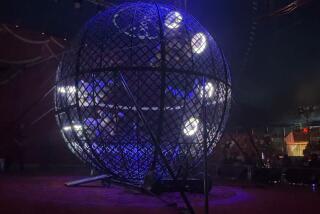WORK STARTS IN LONDON ON GLOBE REPLICA
- Share via
LONDON — It was Sam Wanamaker’s finest hour, and somehow it was fitting that controversy surrounded the moment.
After 17 years of battling local planners, lawyers, an army of doubters and seemingly impossible odds, the irrepressible 68-year-old American actor-director watched quietly from the sidelines as dignitaries helped launch his dream: reconstructing William Shakespeare’s Globe Theater only a few yards from where the original burned to the ground along the banks of the Thames River in 1613.
On Thursday, amid the derelict warehouse district of the river’s south bank across from St. Paul’s Cathedral, Prince Philip, two government ministers and hundreds of invited guests braved a London summer drizzle for the event. Welsh actor Anthony Hopkins opened the ceremony, reading from Shakespeare’s “Henry V,” “Can this cockpit hold the vasty fields of France?”
Nearby, the last of the theater’s 24 wooden foundation posts was lowered into place to polite applause and confident predictions that the $28-million project will quickly become a major London tourist attraction and an important cultural addition once it is completed in 1992.
“I feel exhilarated,” proclaimed Wanamaker. “It’s worth all the struggle.”
In the euphoria of success, the battles that marked Wanamaker’s long fight to create an exact replica of the famous theater seemed over.
They aren’t.
The latest controversy, completely unexpected, has come in the form of a challenge to Wanamaker’s proposed 24-sided design for the theater. Some critics claim it doesn’t even come close to an exact replica.
Historian Martin Clout began the debate with a 100-page paper claiming that two years of research had convinced him the original Globe did not have 24 sides, but only six. Further, Clout contended, both the stage and the flagpole in Wanamaker’s design are in the wrong place.
Next, in a Daily Telegraph article, the head of Wanamaker’s academic advisory board, Reading University Shakespeare scholar Andrew Gurr, rejected Clout’s findings as “a flight of fantasy” and a debate erupted in the paper’s letters columns.
Ruth Richardson, a historian affiliated with the University of London’s Institute of Historical Research, came to Clout’s defense, dismissing the 24-sided structure as “an architectural Frankenstein” cobbled together by literary experts who knew little about how to handle historical data.
“It is a figment, a modern artifact based on a misunderstanding of Elizabethan timber construction methods,” she stated. “Its 24 sides have been decided upon arbitrarily, from a misreading of a picture of the later, second Globe, for which Shakespeare never wrote.”
In an interview, she claimed that pencil drawings at the Yale Center of British Art and the description provided by someone who lived near the theater in those days support her thesis. “The wife of the man who owned land adjacent to the theater described it as ‘hexagonal without and round within,’ ” she said.
Members of Wanamaker’s staff admit there is no hard evidence to refute Clout’s hexagonal idea. Neither is there evidence categorically confirming the 24-sided design.
In fact, the controversy has shown that what little evidence does exist about the design of one of history’s best-known theaters tends to be contradictory.
Those familiar with 16th-Century wood construction methods say a hexagon would have been a cheaper, more logical design for what was an economically marginal venture.
However, Wanamaker’s staff members are quick to defend the 24-sided design as the result of 13 years of consultations with more than 200 Shakespearean scholars.
“Our team has looked at this closely,” said project spokesman Judy Digney. “Unless something absolutely major comes to change our minds, the current building will go ahead.”
Wanamaker himself dismisses the hexagonal idea as a cheap publicity stunt by Clout to promote a book he plans to publish on the Globe. “We’re convinced we’re the closest to the original as we can get,” Wanamaker said Thursday.
Ever the optimist, Wanamaker added with a smile, “Who knows, maybe this will generate more interest in the project.”
He and his organization, the Shakespeare Globe Trust, could use the interest to help generate another $25 million in corporate and private donations needed to complete his dream, which began nearly four decades ago; the trust already has raised about $3 million.
A lifelong Shakespeare buff, Wanamaker was stunned to find that only a small commemorative plaque marked the Globe’s location when he first visited the site in 1949. After years of privately nurturing his dream, he won endorsement from a world Shakespeare convention in 1970 and soon began his protracted battle with British authorities.
Last year, Wanamaker won a court ruling against the local Southwark Council, which had wanted to retain the land as a depot for its municipal street sweepers and their equipment. Planning authorities gave final permission for the project last February.
Whatever the theater’s final shape, the brash American seems likely to succeed where other, more illustrious, figures have failed--including King George IV, poet and novelist Sir Walter Scott and the poet Samuel Taylor Coleridge.
Because the theater will have no roof, the Globe’s season is expected to be restricted to between 16 and 20 weeks during the spring and summer.
The builders of the new theater hope to open it on April 23, 1992, Shakespeare’s 428th birthday, and present four plays a year, from Aprl to September. The opening play will probably be “Henry V” because of its explicit textual referrence to the original Globe, described as a “wooden O.”
More to Read
The biggest entertainment stories
Get our big stories about Hollywood, film, television, music, arts, culture and more right in your inbox as soon as they publish.
You may occasionally receive promotional content from the Los Angeles Times.










